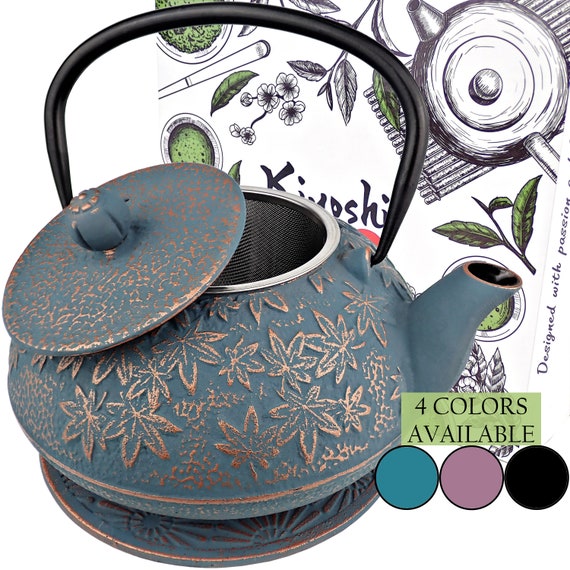Japanese cast iron kettle is a traditional teapot used for heating and brewing water. It is known for its durability and heat retention properties.
With its origins dating back to centuries ago, the Japanese cast iron kettle, also known as a tetsubin, is not only a functional kitchen tool but also a piece of art steeped in cultural significance. The craftsmanship involved in creating these kettles is a reflection of Japanese aesthetics and traditions, making them sought after by collectors and tea enthusiasts worldwide.
The unique design and practicality of the Japanese cast iron kettle have made it a popular choice for tea ceremonies and everyday use. Today, these kettles are available in various designs and sizes, catering to modern needs while still honoring their rich heritage. Word count: 122
Understanding Japanese Tea Culture
History Of Japanese Tea
Japanese tea culture dates back to the 9th century when Buddhist monks brought tea seeds from China. At that time, tea was consumed mainly by the elite and the samurai class. It wasn’t until the 12th century that tea gained wider popularity and became an integral part of Japanese culture. Tea cultivation and processing techniques were refined and tea ceremonies began to take on a more ritualistic nature, emphasizing harmony, respect, purity, and tranquility.
Rituals And Traditions
The Japanese tea ceremony, or “chanoyu,” is a highly ritualized and choreographed event that focuses on the preparation, serving, and consumption of matcha, a powdered green tea. The ceremony is steeped in tradition and symbolism, with every movement and gesture carefully thought out and executed to create a sense of harmony and appreciation for the moment. Tea gatherings are also an essential part of Japanese culture, where people come together to socialize, bond, and appreciate the art of tea making and serving.
Significance Of The Cast Iron Kettle
The cast iron kettle, or “tetsubin,” holds a special place in Japanese tea culture. Traditionally used to boil water for tea, the tetsubin is prized for its ability to evenly distribute heat and enhance the flavor of the water, thereby improving the taste of the tea. Beyond its functional purpose, the tetsubin is also revered for its elegant and timeless design, often adorned with intricate patterns and motifs that reflect the rich history and craftsmanship of Japanese artisans.
Exploring The Craftsmanship Of Japanese Cast Iron Kettles
Japanese cast iron kettles, known as tetsubin, are highly revered for their exquisite craftsmanship and rich cultural significance. From their traditional manufacturing techniques to the symbolism in their design and their crucial role in tea brewing, Japanese cast iron kettles represent centuries of heritage and precision. Let’s explore the meticulous craftsmanship behind these iconic kettles, delving into their production methods, symbolic motifs, and their integral part in the art of tea brewing.
Traditional Manufacturing Techniques
The production of Japanese cast iron kettles is a revered art form that has been perfected over centuries. Craftsmen meticulously shape the iron using traditional techniques, such as sand casting and hand hammering, to create kettles that are not only functional but also exquisite works of art. Each kettle undergoes a painstaking process, involving multiple stages of casting, refining, and finishing to ensure a seamless blend of traditional craftsmanship and modern durability.
Symbolism In Design
Japanese cast iron kettles are not only known for their functionality but also for their symbolic design elements. The intricate patterns and motifs adorning these kettles often carry deep cultural significance, such as natural landscapes, auspicious symbols, or historical emblems. These embellishments not only add to the visual appeal of the kettles but also reflect the rich heritage and values of Japanese culture, making them treasured heirlooms passed down through generations.
Role In Tea Brewing
Beyond their aesthetic allure, Japanese cast iron kettles play a vital role in the art of tea brewing. The superior heat retention of these kettles ensures that water remains at the optimal temperature for brewing delicate teas, bringing out the nuanced flavors and aromas. Their steady, gradual heat distribution and ability to infuse the water with subtle traces of iron contribute to the nuanced art of tea preparation, making them an essential element in the traditional Japanese tea ceremony.
Benefits Of Using Japanese Cast Iron Kettles
Japanese cast iron kettles, also known as Tetsubin, have been prized in Japan for their elegance and functionality for centuries. These traditional kettles are revered for both their aesthetic appeal and their ability to enhance the brewing experience. In this post, we’ll explore the benefits of using Japanese cast iron kettles, including how they enhance the flavor profile, retain heat, and provide health benefits through iron-infused water.
Enhancing The Flavor Profile
Japanese cast iron kettles are celebrated for their ability to enhance the flavor profile of the water used for tea or other hot beverages. The iron material has a natural way of softening and improving the taste of the water, resulting in a cleaner and more nuanced flavor. This unique feature allows for a more authentic and enjoyable brewing experience, making each cup of tea or other hot beverage a true delight.
Retaining Heat And Enhancing Brewing Experience
The superior heat retention properties of Japanese cast iron kettles contribute to an enhanced brewing experience. The material ensures that the water remains at the optimal temperature for a longer period, resulting in a more consistent and flavorful brew. This enables tea enthusiasts to savor each cup at the perfect temperature, regardless of the time passed since the water was boiled, creating a more enjoyable and satisfying drinking experience.
Health Benefits Of Iron-infused Water
One of the most intriguing benefits of Japanese cast iron kettles is the health aspect. The iron infused in the water from these kettles can contribute to an increase in iron levels in the body, which is especially beneficial for individuals with iron deficiency. Iron-infused water also provides a distinct and faintly sweet flavor, while being free from harmful chemicals often found in plastic or other materials. This natural infusion of iron into the water provides a health-conscious, authentic, and environmentally friendly way to consume beverages, offering a host of benefits beyond taste and brewing experience.
Care And Maintenance Of Japanese Cast Iron Kettles
Keep your Japanese cast iron kettle in top condition by gently cleaning it with warm water and a soft cloth. Prevent rust by thoroughly drying the kettle after use and storing it in a well-ventilated area. Regular seasoning with oil can help maintain the kettle’s longevity and luster.
Seasoning And Cleaning
Proper seasoning and cleaning are essential for taking care of your Japanese cast iron kettle. Seasoning a cast iron kettle involves a process of preparing the kettle for use and maintaining its non-stick surface. To season, first rinse the kettle with hot water and then dry it thoroughly. Next, add a small amount of tea oil to the interior and warm the kettle over low heat. Cleaning should be done with warm water and a mild detergent, if necessary. Avoid using harsh abrasives, as they can damage the seasoning and expose the iron to corrosion.
Preventing Rust And Corrosion
Preventing rust and corrosion is vital in maintaining the longevity of your Japanese cast iron kettle. Dry the kettle thoroughly after each use to prevent water from sitting and causing rust. Additionally, store the kettle in a dry place to minimize exposure to moisture. Avoid prolonged exposure to acidic substances, as they can cause corrosion. Applying a thin layer of oil to the interior after use can also help prevent rust and corrosion.
Longevity Through Proper Care
Proper care ensures the longevity of your Japanese cast iron kettle. With regular seasoning, cleaning, and preventing rust and corrosion, your kettle can last for generations. Investing time and effort into maintaining your kettle will reward you with years of use and enjoyment.
The Ultimate Brewing Experience With Japanese Cast Iron Kettle
The Ultimate Brewing Experience with Japanese Cast Iron Kettle
The tradition of brewing and enjoying tea in Japan has been elevated to an art form, and the Japanese cast iron kettle, or tetsubin, plays a significant role in creating the ultimate brewing experience. The combination of heat retention, even heat distribution, and the unique mineral composition of the iron can enhance the flavor and aroma of your favorite teas. Here, we explore the step-by-step guide to brewing, the varieties of tea suitable for brewing, and how the Japanese cast iron kettle can elevate the tea-drinking experience to new heights.
Step-by-step Guide To Brewing
Here’s a simple guide to brewing tea using a Japanese cast iron kettle:
- Fill the cast iron kettle with fresh, cold water.
- Place the kettle on a heat source and allow the water to reach the desired temperature.
- Add the appropriate amount of tea leaves to your teapot or infuser.
- Pour the hot water over the tea leaves and let it steep for the recommended time.
- Pour the brewed tea into cups and savor the flavors.
Varieties Of Tea Suitable For Brewing
Japanese cast iron kettles are suitable for a wide range of teas, including:
- Green tea: The gentle heat from the cast iron kettle brings out the sweet, vegetal flavors of green tea.
- Oolong tea: The heat retention of the kettle allows for multiple infusions, extracting the complex flavors of oolong tea.
- Black tea: The even heat distribution enhances the bold and robust flavors of black tea.
- Herbal tea: The mineral-rich iron can add depth to the earthy and herbal notes of various herbal teas.
Elevating The Tea-drinking Experience
Using a Japanese cast iron kettle not only enhances the brewing process but also elevates the entire tea-drinking experience. The aesthetics of the kettle, along with the improved flavor and aroma of the brewed tea, can create a serene and satisfying ritual for tea enthusiasts. Make your tea time a meditative and rejuvenating experience by incorporating the tradition and functionality of the Japanese cast iron kettle into your daily routine.

Credit: www.etsy.com
Frequently Asked Questions For Japanese Cast Iron Kettle
What Is A Japanese Cast Iron Kettle?
A Japanese cast iron kettle, known as “Tetsubin,” is a traditional tea kettle used for boiling water and brewing tea. It’s revered for its heat retention properties and ability to enhance the flavor of the water and tea.
How To Use A Japanese Cast Iron Kettle?
To use a Japanese cast iron kettle, simply fill it with water and place it on a heat source. It’s suitable for use on a stovetop or a teapot warmer. Remember to avoid rapid temperature changes to prevent damage and rust.
What Are The Benefits Of Using A Cast Iron Kettle?
Using a cast iron kettle allows for superior heat retention, which ensures that the water stays hot for an extended period. Additionally, the iron infuses the water with traces of beneficial minerals, enhancing the flavor and nutritional benefits of the water.
How To Clean And Maintain A Cast Iron Kettle?
To clean and maintain a cast iron kettle, hand wash it with warm water and mild soap, then thoroughly dry it to prevent rust. Avoid using abrasive materials or harsh detergents. Periodically, you can also oil the kettle to maintain its sheen and prevent oxidation.
Conclusion
Japanese cast iron kettles are a timeless kitchen accessory, cherished for their beauty and functionality. Their ability to distribute heat evenly makes them perfect for brewing tea and infusing flavors, while their durability ensures they stand the test of time.
Embrace the tradition and elegance of Japanese culture with a cast iron kettle in your home.








